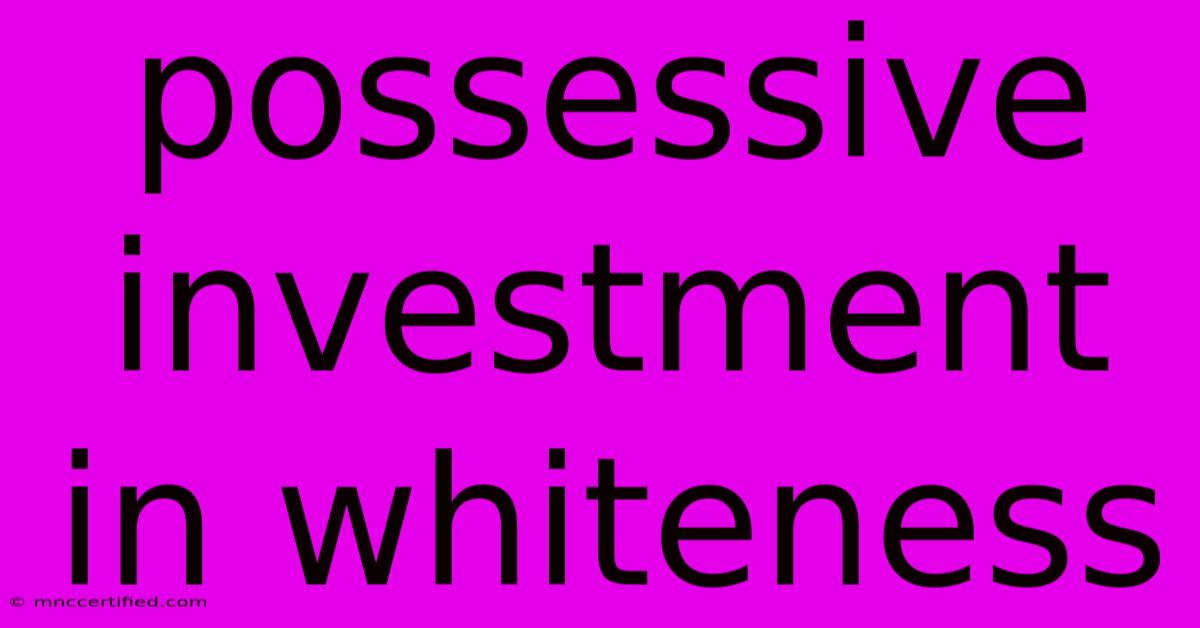Possessive Investment In Whiteness

Table of Contents
Possessive Investment in Whiteness: Understanding its Impact
The concept of "possessive investment in whiteness" describes the ways in which white people benefit from and actively defend a system that privileges them based on their race. It's not simply about individual prejudice, but a deeply ingrained system that shapes social structures, institutions, and individual behaviors. This article delves into this complex issue, exploring its historical roots, its manifestations in contemporary society, and its implications for achieving racial justice.
Historical Roots of Possessive Investment in Whiteness
The possessive investment in whiteness is deeply rooted in the history of colonialism, slavery, and Jim Crow laws. These systems weren't just about individual acts of oppression; they were structured to systematically transfer wealth and power to white people at the expense of people of color. Land ownership, political power, and economic advantage were all explicitly tied to whiteness, creating a legacy of inequality that persists to this day.
-
The legacy of slavery: The enslavement of African people in the Americas generated immense wealth for white landowners and fueled the growth of the American economy. This wealth was accumulated through forced labor and exploitation, establishing a foundation of white privilege that continues to benefit white Americans today.
-
Redlining and discriminatory housing policies: Historically, redlining and other discriminatory housing practices deliberately excluded people of color from accessing homeownership and building wealth, further concentrating wealth and resources in white communities. This created a wealth gap that continues to widen, perpetuating the possessive investment in whiteness.
-
Jim Crow Laws and segregation: These laws enforced racial segregation and discrimination in virtually all aspects of life, denying people of color access to education, employment, and other opportunities. This systemic oppression directly benefited white people by limiting competition and maintaining their dominant position in society.
Manifestations of Possessive Investment in Whiteness Today
While overt forms of racism are less socially acceptable, the possessive investment in whiteness continues to manifest in subtle but powerful ways:
-
Implicit bias and microaggressions: Everyday interactions can reveal unconscious biases that favor white people, perpetuating inequality. These microaggressions, though seemingly small, cumulatively contribute to a hostile environment for people of color.
-
Systemic inequalities in education, employment, and the justice system: Despite legal progress, racial disparities persist in access to quality education, employment opportunities, and fair treatment within the criminal justice system. These systemic inequalities reflect and reinforce the possessive investment in whiteness.
-
Resistance to anti-racist initiatives: Efforts to address racial inequality often face resistance from those who benefit from the status quo. This resistance can take the form of opposition to affirmative action, critical race theory, or other policies designed to promote racial justice. It's a direct defense of the existing power structure.
-
Colorblind ideology: The belief that ignoring race will lead to equality is a harmful misconception. Colorblindness fails to acknowledge the historical and ongoing impact of racism and prevents meaningful efforts to address systemic inequalities. This is often a manifestation of a subconscious defense of the privileges inherent in whiteness.
Challenging the Possessive Investment in Whiteness
Addressing the possessive investment in whiteness requires a multifaceted approach:
-
Promoting anti-racist education: Educating ourselves and others about the history and ongoing impact of racism is crucial to dismantling this system. This involves challenging colorblind ideology and acknowledging the ways in which we all benefit from and perpetuate systems of oppression.
-
Supporting policies that promote racial justice: Advocating for policies that address systemic inequalities in education, employment, housing, and the criminal justice system is essential to creating a more equitable society.
-
Engaging in critical self-reflection: White people need to engage in honest self-reflection to understand their own complicity in perpetuating the possessive investment in whiteness. This process can be challenging but is necessary for meaningful change.
-
Building solidarity with people of color: Working alongside people of color to address racial injustice is crucial. This involves listening to their experiences, amplifying their voices, and working together to build a more just and equitable society.
Understanding and challenging the possessive investment in whiteness is not just about individual acts of kindness; it's about dismantling a deeply entrenched system of power and privilege. By confronting this complex issue head-on, we can work towards creating a society where everyone has the opportunity to thrive, regardless of their race.

Thank you for visiting our website wich cover about Possessive Investment In Whiteness. We hope the information provided has been useful to you. Feel free to contact us if you have any questions or need further assistance. See you next time and dont miss to bookmark.
Featured Posts
-
At Home Sleep Apnea Test Insurance
Nov 17, 2024
-
Cost Of An X Ray Without Insurance
Nov 17, 2024
-
Florida Defeats Lsu 27 16
Nov 17, 2024
-
Ufc 309 Jones Vs Miocic Full Details
Nov 17, 2024
-
Beauty And The Beast Trading Cards
Nov 17, 2024